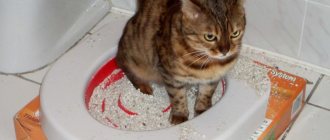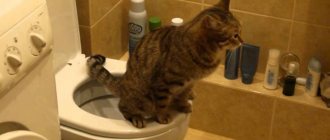What will you learn from the article?
- How to litter train a kitten - step by step instructions Step 1. Choose the right place
- Step 2: Limit the kitten's movement around the house
- Step 3: Choose the right tray
- Step 4: Choose the right litter
- Step 5. Show the kitten the litter box
- Step 6: Use Positive Motivation
- Step 7: Handle Accidents Carefully
- What to do if the kitten does not want to go to the litter box
- The best means
In this article you will learn how to train a kitten to use the litter box yourself. Step-by-step instructions for those who have just bought a kitten, whether it is worth using training products, answers to all questions on this topic.
Tray selection
Cats are very clean by nature, so they themselves will be happy to go to one place. The owner can only provide all the conditions for this. In order for a small resident to go to his litter box, it is necessary that this tray does not bring any discomfort to the baby. That is, the animal must enter it freely and remain there calmly.
To do this, you need to pay attention to the sides of the tray. Because of the high sides, the kitten will not be able to climb where he needs to go. Therefore, instead of overcoming an obstacle, he can calmly do all the things nearby. And it’s not his fault - when should you look for time to overcome obstacles, when you urgently need to go to the toilet!
Many people think that it is better to immediately buy a larger litter box so that they don’t have to spend money twice on the toilet, because cats grow quickly. This is debatable. The cat potty is not too expensive. But a large toilet also has large sides. And this is not very convenient for kids. The conclusion is simple - for small kittens size is not so important; a large “springboard” is not required now. But the sides should be low so that time is not wasted on conquering them. After all, you can then spend money on a luxurious cat “bathroom”.
Remember! The tray is not Elbrus, cats will not conquer it, they will find a more convenient place. And it is very important that the tray be purchased before the new tenant arrives in the house. This is necessary in order not to retrain the kitten.
Leave a request for a cat hotel
Special nozzles for the bathroom
You can order special toilet attachments directly from a pet store or online. They have different diameters, which makes it easy to train a baby and an adult pet to go to the toilet. Take the nozzle with the smallest hole from the kit and install it on the bathroom. 3 days will pass, the pet will get used to it and change it to a nozzle with a large hole. When your pet learns to go to the toilet with the nozzle that has the largest diameter hole, remove it completely.
Now you won't need to waste time and effort on daily cleaning of the tray. There will be no foreign odors of cat urine or excrement. The pet will always have clean paws, which means the apartment will be cleaner.
Which filler to take
Now you can find special gel fillers that instantly absorb all moisture.
Kittens like to be dry, so they willingly go about their business in their potty. If there is no special signature on the packages “For kittens,” it is better to choose a filler that is not too coarse. This way it will be more convenient for the little paw to bury “traces of crimes.”
At first, you need to make sure that the baby does not try the filler on the tooth. This often happens, the owner should stop this action.
If it is absolutely impossible to buy filler, then you can use sand or torn newspaper. True, in this case the pot will not rid the room of the unpleasant smell, even if you clean it almost immediately. Numerous practices have already proven that you should not skimp on filler. Many of them are very inexpensive, it is spent sparingly, and the air in the room remains fresh, there is no dirt on the floors (like after a pot of sand), and the cats themselves prefer special fillers.
Find a convenient location for the litter box
This factor is very important. An inconvenient place can wean even a trained cat from going to the litter box. To prevent this from happening, the location should be thought out in advance. Many owners place the litter box in their litter box. This may be the right decision, but wherever the tray is placed, the following factors must be considered:
- The cat needs constant access to its litter box. Therefore, if the “potty” is placed in a human bathroom, the door there should always be open;
- during the “process” itself, the cat should not be in a cramped position (in other human toilets there is so little space, and the tray is pushed so far that cats have to bend their heads or take other unnatural positions);
- It is better to place the tray on a rubber mat. This way, the tray itself will not slip (if the floors are too smooth), besides, immediately jumping out of the tray, the cat will be able to leave grains of filler on the rug, rather than drag them into the room;
- You definitely need to find a place where no one interferes with the cat in such an important process. Once scared of something, the cat may never go to the litter box to do its business again. And in general, she will be able to develop a negative association with the tray itself;
- First, the tray can be placed where the little resident of the room is located, and after the ability to go to the toilet is firmly established, and the cat himself has become accustomed to the entire apartment, the tray can be moved to a permanent place.
Step-by-step steps - how to train a kitten to use the litter box
In order to teach a kitten to go to the litter box, it is better to do this in several stages. Below are step-by-step instructions on what to do and why.
Stage one - getting to know each other
If a tiny pet is purchased from a good breeder, then special training efforts will not be required. The kittens are trained by the breeder, and the new resident will only have to get used to it, take a closer look, and update the new “potty.”
If a kitten grows up with its mother, a cat, then the person also has nothing to do - the mother herself will teach him everything (although it is better to buy a tray with small sides). If there is no one to help the baby except a person, then the owner himself will teach.
To do this, you first need to determine the location of the kitten itself. You shouldn’t immediately let your baby travel around the entire apartment. It is better if the baby lives in a large box for now. This way he can get used to it a little, and at the same time get used to the tray.
So, the first stage is getting to know each other. You should make it clear to the child that the person is a friend, his hands are affectionate, and contact with the person is pleasant. To do this, you need to stroke the kitten, scratch behind the ear, and pick it up. So the baby very quickly gets used to the owner, to his hands, and this gives him pleasure.
Why does “familiarization” refer to “Litterbox Training”? Because the person will have to take the animal, put it in the tray, and the cat will have to absorb new knowledge, and not waste its attention on fighting human hands, not tremble with fear, and not study the hands themselves.
At the “acquaintance” stage, the baby learns where the food and water are in the box and how to get out of here (to do this, you must first make a “door” in the box).
Stage two - we observe and help
If you are patient and observe the kitten’s behavior, you will notice that he goes to the toilet immediately after he wakes up, as well as after he eats.
This should be used in training. That is, when the kitten wakes up, he immediately begins to look for a place and worry, because he has the urge to relieve himself. The owner immediately takes the kitten and puts it in the tray (which is located next to the box). And until the cat does its business, it must be gently held in the tray. After the baby has done everything, he needs to be praised with a voice, stroked, you can treat him with something tasty and put him back in the box.
The same must be done after the baby has eaten. To make it more convenient to monitor your pet’s behavior, you should feed it at the same time. This should be done every time after waking up and eating, until the kitten itself understands what and where it should do.
Cats have different mental abilities, but litter box training does not take much time. If the owner does not make serious mistakes, the kitten can be trained to use the litter box quickly; this will take from several days to a week.
Stage three - fixing it
At this stage, the acquired knowledge is consolidated. At this time, you can move the tray to other places. At first, the “potty” should be moved short distances, then, when the pet grows up and firmly understands where to go when needed, the tray can be moved to a permanent place.
There will be nothing bad if the cat has several trays, for example, one is already in a permanent place, and the other is in the farthest corner of the apartment.
Reasons for possible difficulties
When developing the skill of defecating in the right place, difficulties sometimes arise. They can be caused by various reasons. Just watch your pet to understand why training is so difficult.
Sometimes it happens that an animal went to the toilet in the right place, and then suddenly stopped. In this case, you need to understand what causes this behavior and how to re-accustom an adult cat to the litter box.
Disease
The most dangerous and unpleasant reason for refusing to go to the toilet is illness. If something is bothering your pet, he may change his behavior in an attempt to let you know that something is hurting him.
In some cases, due to illness, he simply forgets where to go to the toilet, or this process causes him severe discomfort and pain. This may be urolithiasis, kidney failure or cystitis. If you notice changes in the animal's behavior, anxiety, lethargy, or other symptoms of the disease, you should contact your veterinarian. After the course of treatment, your pet will recover and, most likely, will return to its usual toilet.
Stress
Litter box refusal can also be caused by stress. It is worth considering that cats, like people, have different personalities and stress tolerance. Therefore, each requires a special approach. Limit the animal from stress as much as possible, be patient, do not punish the cat for mistakes - and very soon she will understand what you want from her.
It happens that changes in life circumstances cause anxiety in an animal. For example, a new person has appeared in the family or someone has died. In this case, try to devote as much time as possible to your pet. If you have a second cat, you should designate a litter tray for each pet.
New tray or new place
Cats are animals that do not tend to change their habits; they quickly become attached to their territory and certain places. Therefore, when changing the tray, a problem may arise such as refusal to go to the toilet in the usual place. What can we say about moving?
If you change the tray, sometimes you have to start training again - be prepared for this. If you are planning a move, make sure the new location has privacy areas for the cat and elevated areas for observation. The fewer reasons for stress the animal has, the better the adaptation will be and the fewer problems will arise with the toilet.
The period of sexual hunting
Sometimes difficulties are caused by the so-called mating season. It’s quite easy to check whether a cat leaves marks intentionally or whether there is another reason for his behavior. If the pet becomes more restless - it looks from the outside as if he is looking for something - and the animal urinates in small portions on a vertical surface, then we can definitely talk about the cat’s sexual activity. The solution is castration or regular mating with a cat.
Psychological reasons
There is an opinion that a cat can leave puddles out of spite, thus showing its stubbornness and discontent. Not all experts recognize this possibility - there are supporters of the theory that cats do not have consciousness, therefore, they do not know how to take revenge. In fact, many owners know that a cat can take a shit if it is offended - but almost immediately. Animals are definitely not capable of delaying revenge and serving it cold.
Best articles: What is called a desert in geography? Definition, examples and types
If your pet is loved and caressed, but he still walks in the wrong place, first of all you need to rule out the disease. If everything is fine in this regard, you need to decide how to most gently accustom an adult cat to the litter box again, taking into account the identified reason: often puddles or piles become an attraction for the owner’s attention. A couple of examples:
The cat feels sad when left alone for a long time. The owner returning late finds a fragrant “gift” in an unexpected place. Getting a second pet will solve the problem.
The cat likes or doesn’t like something. If he wants to go for a walk, but they don’t let him in, he can shit under the door. Or there is a desired item in the closet, which means the cat can go near the door of this closet.
More complex causes are difficult to identify. Sometimes monitoring an animal takes several weeks, or even months. But patient owners cope with the problem, no matter how ingenious it may be.
We train a kitten at different ages
Kittens come to people at different ages. It is not always a baby who is just separated from a cat and immediately finds a caring owner. It happens that a kitten has already gained street experience in its short life, or is used to going and doing its business wherever it pleases. But this can also be fixed.
Kitten up to 3 months
This is the most rewarding age for training. The baby immediately receives the correct knowledge, and it is established for the rest of his life.
At this age, it is very important for the owner not to make serious mistakes. Otherwise, due to human fault, the cat will never go to the litter box, and the animal will be blamed.
Kitten from 3 to 6 months
These are already grown up kids. And, if he is still not accustomed, it means that he did his business wherever he wanted. To accustom such a “free dog” to the tray, you will have to apply a little more patience, and it will take a little more time.
And all the same, no matter how stubborn the new tenant is, the owner should under no circumstances lose his temper. Otherwise, you can disturb the pet’s psyche, undermine its trust, and the training process can drag on for a long time.
For all animals, experienced owners give reliable advice. Here, for example, are 5 ways to train:
- In the first 1-3 days, limit the baby’s place of stay, use, for example, a box, a special carrier or a cage (this makes it easier to clean up after the animal, and the kitten will become accustomed to the litter box faster).
- Place the baby in the tray immediately after waking up and eating.
- Take the kitten's paw in your hands and bury the litter with this paw, instinct will turn on.
- If the cat refuses to visit the litter box, you need to observe where she goes “on business” most often and put the litter box there.
- Do not ignore special sprays that help in toilet training of animals.
conclusions
Tray training a Siamese cat will require owners to be patient and understanding of the pet's needs. If you approach the learning process competently, you can expect to quickly consolidate the acquired skills. In this case, the owner will remain the best friend, and not someone from whom you should keep your distance.
Return to content
What not to do
When a person takes an animal and begins to accustom it to the tray, he can commit a number of violations that greatly impede the animal’s adaptation, and even more so, the accustoming process itself. Here are just a few factors that the owner should not allow in his behavior:
- You should never yell at a kitten if it cannot immediately understand what it should do. The baby will only get scared, and subsequently he will go to the toilet anywhere, but not where he should. And all because he will be afraid of this place;
- You cannot poke a kitten’s nose into its own puddles (as has always been practiced before). He will be afraid of the owner, and certainly will not immediately visit the tray;
- assault is strictly prohibited. It’s better to sign up for a boxing class than to beat unresponsive crumbs;
- there is no need to rush things. For example, if a kitten has just started going to the litter box in one place, you do not need to immediately take the tray to another place, the kitten may lose its “potty”;
- You should not demand instant results from your baby, everyone learns differently;
When training, you must definitely pay attention to the health of your pet.
Subtleties of education
Sometimes the owner just needs to show the pet his displeasure. It should be expressed immediately at the moment the offense is committed (later it will be completely ineffective).
Allowed Methods
Permitted methods of influencing animals include:
- raising the tone towards the cat (with the obligatory pronunciation of its name);
- light tapping on the forehead (not painful, but quite unpleasant);
- stomping, clapping, hitting with a towel in close proximity to the animal.
Many Siamese cats begin to misbehave due to lack of attention from their owners. Love for pets is the best time-tested way to raise animals.
Prohibited tricks
Under no circumstances should you hit a cat, because an adult can easily injure the animal . The pain that a cat experiences is unlikely to help it draw the right conclusions about its behavior. Most likely, the pet will prefer to stay away from the offender, will stop responding to punishment, or will begin to show aggression in response.
Return to content
What to do if a kitten or cat does not go to the litter box
It happens that a smart animal, even an adult one, suddenly refuses to go to the litter box. You shouldn’t panic and scold your pet, you need to analyze why this happened. This can happen for several reasons:
If the cause has not been established, it is best to visit a veterinarian with your pet, because very often smart animals thus attract the owner’s attention to some of their hidden problems.
What if nothing works out?
Sometimes it happens. True, “nothing works” - this means that it is impossible to easily and quickly train a cat to go to the litter box in a week - a month or another time period. It may take up to 2 months or more.
There have been known cases where an adult street cat that came into the house was trained to use a litter box within six months. Daily. In the end, the rebel gave up.
If all else fails, you can suggest the following:
- use special chemicals. Currently, there are sprays to accustom cats to the litter box and to scare the animals away from other places they have chosen for the toilet;
- completely move the tray to another location;
- place several trays throughout the apartment;
- show more observation - maybe the reason will reveal itself;
- contact a veterinarian, perhaps the reason lies in the animal’s well-being.
You can train kittens in different ways, the main thing is to be patient and believe that everything will work out.
Remember, if you need a hotel for your pet, we will always be glad to see you in our hotel Cat Lounge
Training systems
Pet stores sell special seats for toilet training a cat. The device is a plastic cover with rings. The seat is installed on the toilet, first the smallest ring in diameter is cut out, then as the cat gets used to it, the next ones are cut out.
- Move the tray to the bathroom.
- Replace the old tray with a training seat, add filler (often included). It is acceptable to use wood or any other filler that can be washed off. It is advisable to pour a little wet litter into the fresh one so that the cat gets used to it faster.
- Gradually raise the system to the level of the toilet rim (as described above).
- Install the trim under the rim. The design is durable and does not move. But before you buy, you should take measurements of the toilet seat so as not to make a mistake with the size.
- Initially, put a box for the cat to make it easier for her to jump.
- If the cat refuses to be housed in a new structure, use catnip to attract it. The main thing is not to overdo it, otherwise the pet may become overexcited.
- Once the animal is comfortable, the next step is to remove the smallest insert. Gradually remove the remaining inserts until the largest one remains, but with narrow sides that will serve as support for the paws. Filler is used all this time.
After what period of time you remove the insert rings depends on the pet’s behavior. According to reviews from cat breeders, on average the interval between removal of inserts takes 2-3 weeks
It is important to consider that the more time allocated to each stage, the more the cat’s habit of going to the toilet will become stronger.
If at some stage the cat began to ignore the exercise machine and began to shit anywhere, you need to return to the previous stage. To do this, use the appropriate insert or additional attachment from the training system kit.
If the cat is heavy, then the system may be pressed under the weight. Then a spare seat is installed, and the structure will become stronger. For example, an additional nozzle is provided in the Domakot system.
The method with a simulator is guaranteed to accustom the cat to the toilet, but is not entirely convenient for pets. Each time the nozzle must be removed
This is why patience on the part of the owners is so important.











